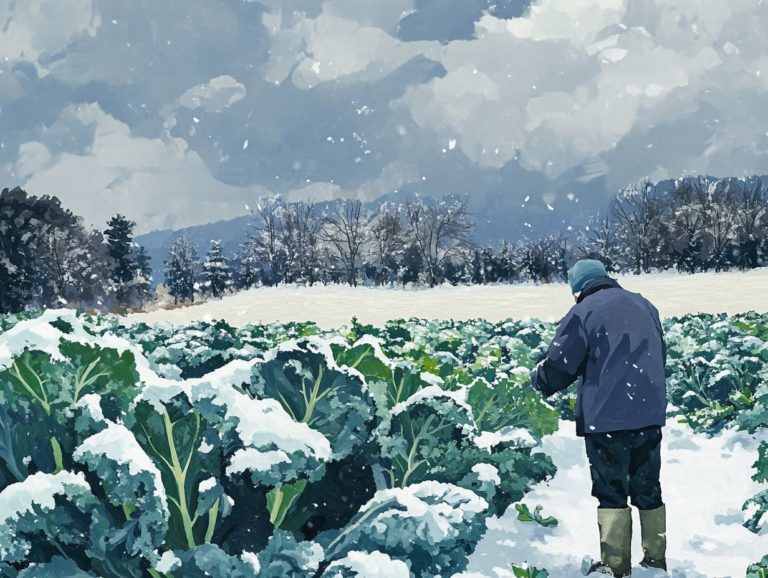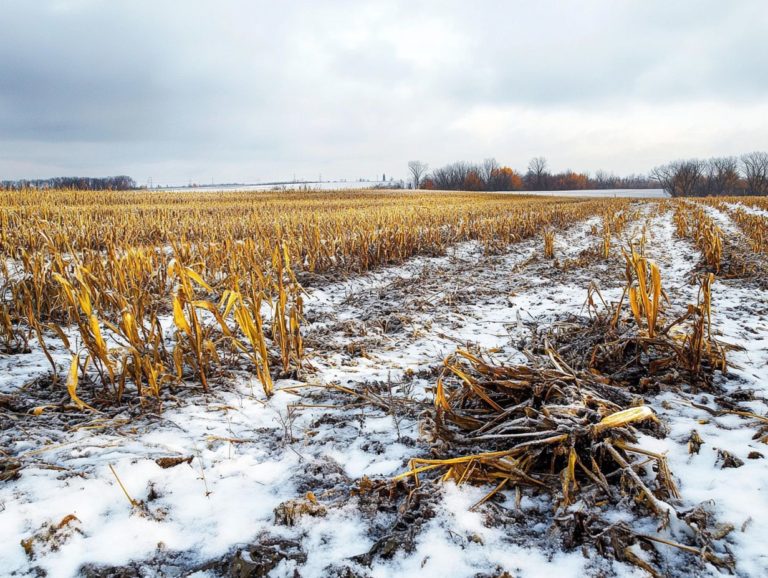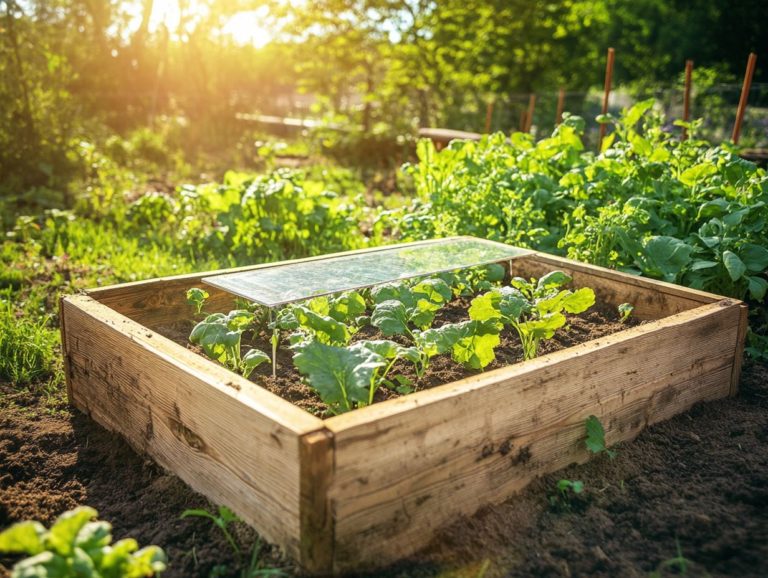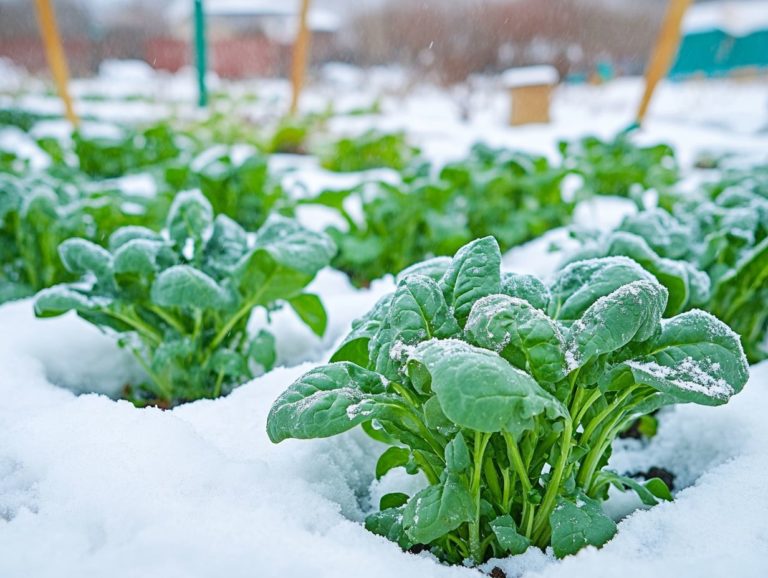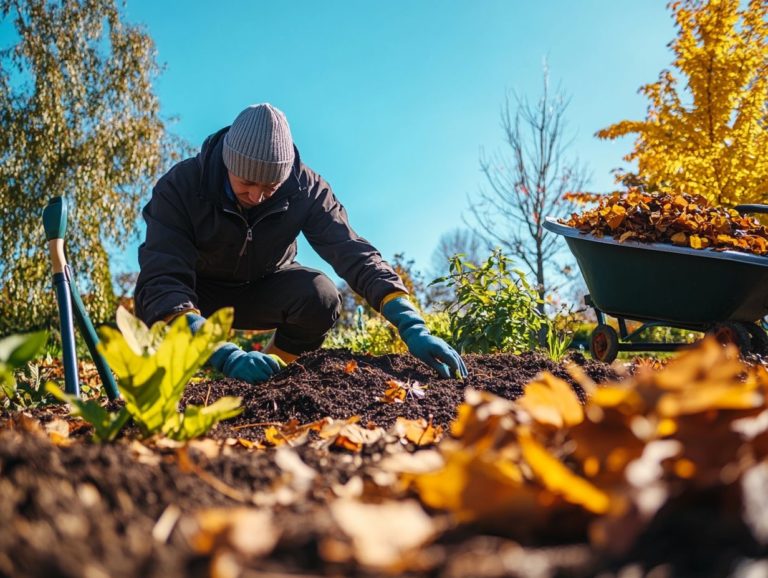5 Tips for Growing Garlic in Cold Weather
Garlic is a cherished staple in kitchens across the globe. Growing it can be especially rewarding, even in colder climates.
You’re in for a treat as you learn how to grow garlic even in winter! If you re eager to cultivate this aromatic bulb but find yourself uncertain about how to tackle the challenges posed by chilly weather, you ve come to the right place.
This article presents five essential tips that will guide you toward a successful garlic harvest. We ll cover everything from selecting the ideal varieties and preparing the soil to safeguarding your plants against frost.
Prepare to uncover the secrets of growing garlic in winter!
Contents
- Key Takeaways:
- 1. Choose the Right Variety
- 2. Prepare the Soil Properly
- 3. Plant at the Right Time
- 4. Protect Your Garlic from Frost and Cold Temperatures!
- 5. Harvest and Store Your Garlic Properly!
- What Are the Best Varieties of Garlic for Cold Weather?
- Frequently Asked Questions
- What are the recommended tips for growing garlic in cold weather?
- How do I know which variety of garlic is best for cold weather?
- When should I plant garlic for a successful harvest in cold weather?
- How can I protect my garlic from freezing temperatures?
- Can I grow garlic in containers in cold weather?
- Is it necessary to water garlic during the winter in cold weather?
Key Takeaways:
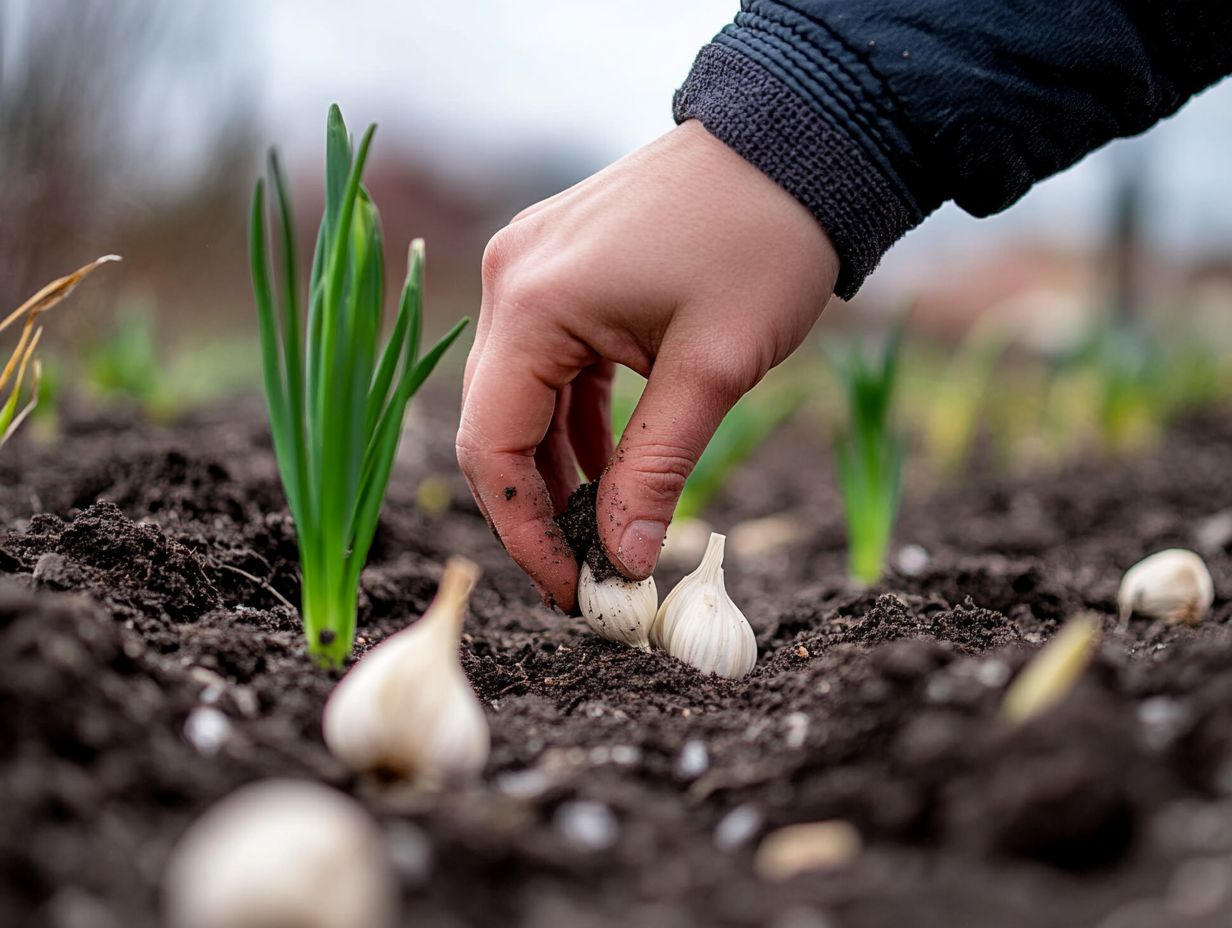
- Choose a cold-hardy garlic variety for successful growth in colder climates.
- Prepare the soil by adding organic matter and ensuring proper drainage.
- Plant garlic in late fall for optimal growth in cold weather.
1. Choose the Right Variety
Selecting the right garlic variety is key to successful cultivation. This is especially true for winter garlic, which thrives in colder climates and brings unique flavors to your culinary repertoire.
Consider a range of characteristics like flavor intensity and growth habits. You can tailor your choices to suit your gardening goals.
- Bogatyr is famous for its robust, spicy flavor and exceptional storage qualities, making it a go-to for chefs.
- Polish Softneck offers a milder taste and adaptability, allowing it to flourish even in milder winters.
- German White is celebrated for its strong aroma and impressive yields.
- If you’re into gourmet cooking, hardneck varieties like Chesnock Red produce beautiful curly scapes and deliver rich, complex flavors.
By evaluating these unique traits, you can optimize your garlic garden. This ensures a bountiful harvest that enhances your culinary creations.
2. Prepare the Soil Properly
Proper soil preparation is essential for your garlic cultivation. It directly influences both the growth of the garlic and the quality of the bulbs you ll harvest.
To set yourself up for success, consider conducting a thorough soil check. This will assess pH levels, nutrient content, and soil texture, pinpointing the specific amendments needed to create optimal conditions for your garlic.
For instance, incorporating organic matter like compost can greatly enhance both soil fertility and structure.
Utilizing organic mulch serves a dual purpose: it insulates the soil to help regulate temperature fluctuations and aids in moisture retention, which is crucial for growing strong bulbs.
By practicing diligent nutrient management, you can ensure that your garlic plants thrive and better withstand environmental stressors.
3. Plant at the Right Time
Timing is crucial when it comes to planting garlic, as it directly impacts the success of your crop and the vitality of the cloves.
Understanding the ideal planting times for different garlic varieties, like hardneck and softneck, can significantly enhance your yield.
Generally, hardneck garlic flourishes when planted in the fall, ideally between September and October, as it thrives in cooler temperatures. Softneck garlic allows for planting in both fall and spring, depending on your climate.
Don t underestimate the importance of soil temperature; most garlic varieties prefer it to hover between 50 F and 70 F for optimal root development.
Preparing your garlic cloves is just as vital. Separate the cloves a few days prior to planting and store them in a cool, dry spot.
Watch the soil conditions as well. Monitor moisture levels and temperature to ensure you re creating the best environment for successful planting.
Don t wait start preparing your soil now for the upcoming planting season!
4. Protect Your Garlic from Frost and Cold Temperatures!
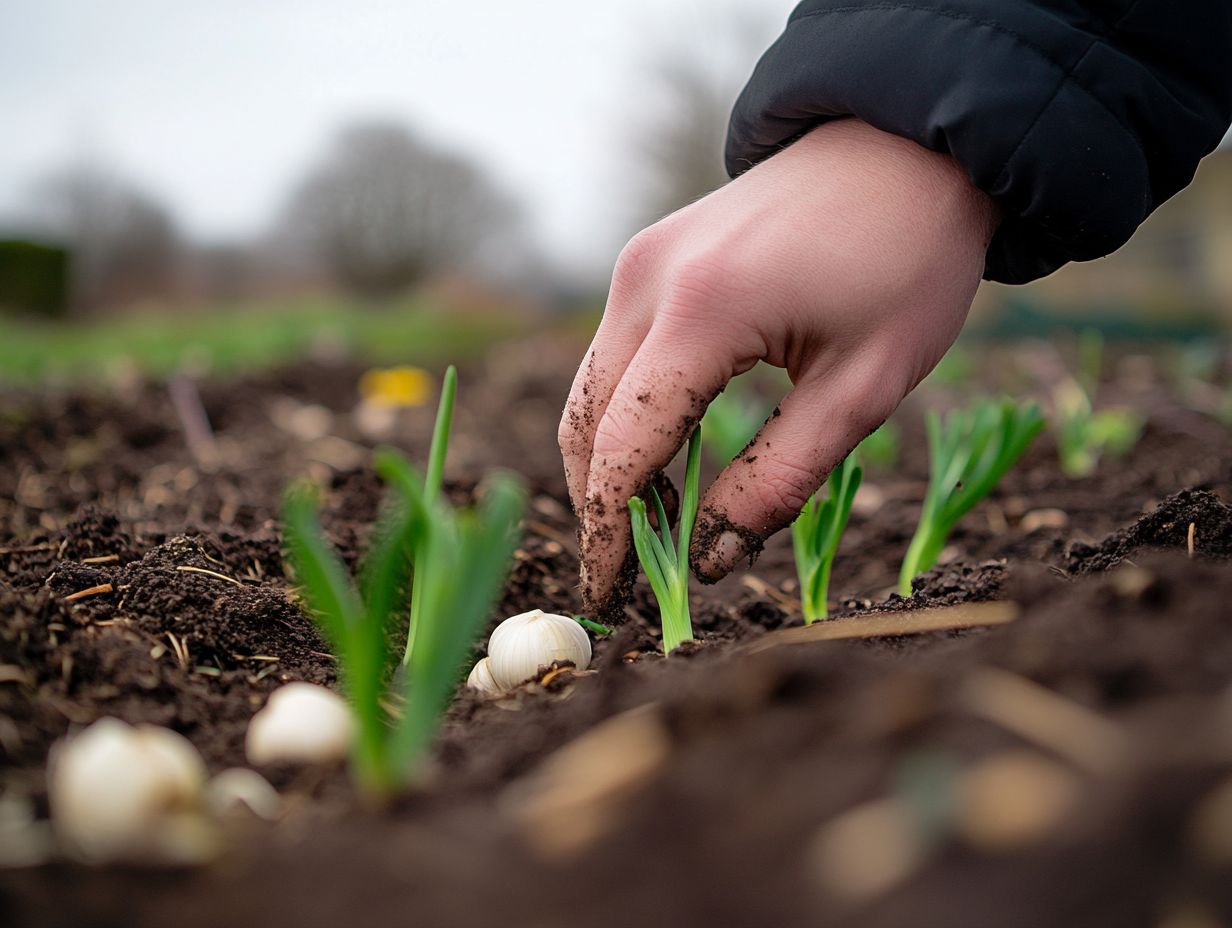
Protect your garlic to ensure a thriving harvest! Frost and cold temperatures can hinder growth and damage young shoots. Employing effective mulch techniques a protective covering placed on soil to retain moisture and regulate temperature will help insulate the soil and maintain a stable temperature, acting as a barrier against harsh winter conditions.
Consider placing row covers or frost blankets over your garlic patch to safeguard against extreme weather fluctuations. For those interested in expanding their gardening skills, exploring top tips for growing kale in cold climates can also promote healthy garlic bulbs and ensure a robust crop come spring.
Incorporating organic mulch, such as straw or shredded leaves, effectively traps warmth and prevents soil freeze, creating an optimal environment for development. Some growers find success with hoops to create a mini-greenhouse effect, capturing heat during the day and shielding against nighttime chill.
These protective measures enhance your plants resilience and encourage a quicker start to the growing season, ultimately leading to larger and more flavorful bulbs. By investing time in safeguarding your crops, you can significantly elevate the overall yield and quality of your garlic, making it a worthwhile endeavor for any gardener.
5. Harvest and Store Your Garlic Properly!
Harvesting and storing garlic properly is crucial for preserving the quality of your garlic bulbs and extending their shelf life after a successful crop. Timing your garlic harvest is essential; pulling them too early or too late can lead to pest management challenges and make them more susceptible to diseases.
To find the perfect moment to pull your garlic, look for signs such as the yellowing of the lower leaves and the leaves starting to dry out. This usually happens in mid to late summer, depending on the variety and local climate conditions.
After you ve carefully uprooted the bulbs, allow them to cure in a well-ventilated area, ideally in the shade, to prevent any mold from forming. For storage, consider using containers like mesh bags or wooden crates, as these provide the necessary airflow that garlic needs.
Common mistakes to avoid include:
- Avoid storing garlic in plastic bags they trap moisture and can lead to rot.
- Avoid placing it in overly humid or warm environments, which will drastically reduce its shelf life.
What Are the Best Varieties of Garlic for Cold Weather?
Selecting the right variety can dramatically influence the success of your crop when cultivating garlic in cold weather. Hardneck garlic varieties, like Bogatyr and Chesnock Red, thrive in harsh winters and offer rich, complex flavors. For more guidance, check out this resource on how to successfully grow garlic in winter. You can also grow softneck garlic varieties, such as Polish Softneck and German White, in these climates, as they yield robust bulbs perfect for long-term storage.
It s essential to understand the differences between these two categories to maximize your harvest. Hardneck varieties typically produce a flower stalk known as a scape (the edible flower stem), which you can harvest for culinary use, enhancing the flavor of your dishes. On the other hand, softneck types tend to be more resilient and may produce a higher bulb count, making them ideal for those looking to stock up.
If you prioritize intense garlic flavor, hardneck varieties often deliver a spicier, bolder taste. However, if you value reliable storage and ease of growth, softneck options provide a versatile solution that can withstand varying degrees of cold weather.
Start implementing these tips today to grow the best garlic possible!
Discover the Perfect Soil for Frost-Resistant Garlic!
The type of soil you choose is crucial for successfully growing garlic in cold weather. Well-drained soil is your best bet to encourage robust development. For those interested in expanding their gardening skills, following 5 tips for growing onions in cold weather can also be beneficial. Managing the right nutrients is essential because garlic thrives on a balanced mix, especially during challenging winter conditions.
Soil texture and organic matter are vital for garlic growth. Adding compost and ensuring good drainage will lead to healthier bulbs.
For optimal cultivation, aim for loamy soil rich in organic matter that promotes airflow and moisture retention. Amending the soil with well-rotted manure or aged compost will elevate nutrient levels and improve soil structure. Test the soil pH and adjust it to a slightly acidic to neutral range (6.0 to 7.0) to create an ideal environment for garlic roots.
Mulching with straw or leaves preserves moisture and regulates soil temperature during colder months, allowing for steady growth.
These practices enhance the soil s natural qualities and contribute significantly to the overall health and yield of your garlic crop.
When Is the Best Time to Plant Garlic in Cold Weather?
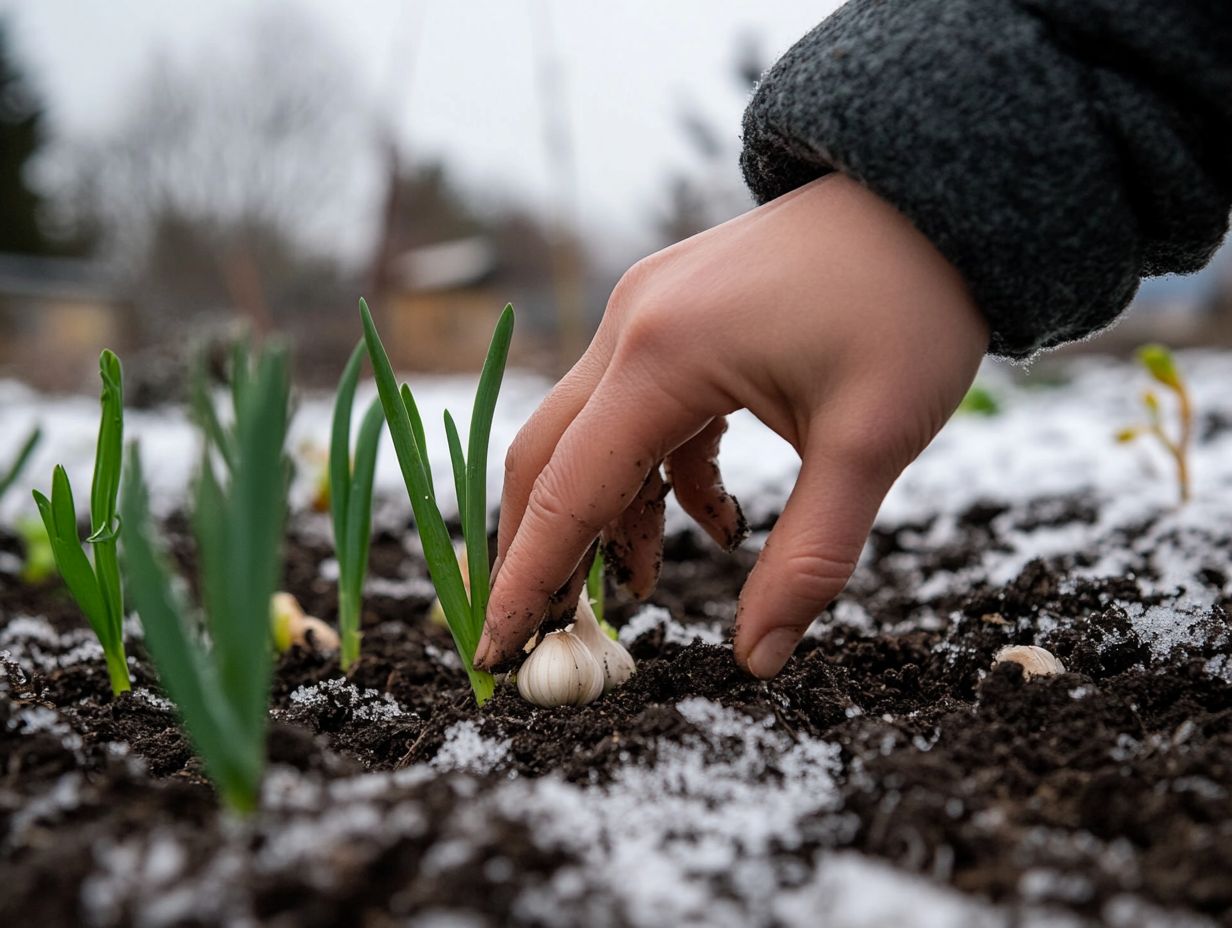
Timing is crucial when planting garlic in colder weather. Fall is the optimal time to ensure those cloves establish strong roots before winter settles in. Aim for planting when the soil temperatures hit around 50 F (10 C), typically from late September to early October.
This careful timing allows your garlic to develop a robust root system that can withstand harsh frost. If you re in a warmer climate, consider planting a bit later. Those in colder regions should stick to the earlier window to avoid the risk of the ground freezing solid.
Planting at the right time enhances growth and significantly impacts the size and quality of your garlic bulbs.
A strong foundation ensures your plants can absorb nutrients efficiently, leading to a bountiful yield come summer.
How to Protect Your Garlic from Frost and Cold Temperatures?
To protect garlic from frost and chilly temperatures, employ several effective methods that safeguard your crops throughout winter, including the top 5 tips for planting in cold climates.
Using organic mulch techniques, such as straw or shredded leaves, acts as a cozy blanket, insulating the soil and maintaining stable temperatures around your garlic bulbs. For those looking to enhance their planting strategy, following the top 10 tips for planting cold-weather bulbs can be beneficial. Adding row covers offers an extra layer of protection against frost while allowing sunlight to filter through, keeping your plants healthy and resilient.
In colder regions, layering mulch can significantly boost its effectiveness. A thicker layer retains warmth and maintains consistent moisture levels. When choosing row covers, select breathable fabric to prevent moisture buildup while allowing for proper ventilation.
These protective measures are vital. They shield your garlic from extreme temperatures and promote robust growth when spring arrives. Start protecting your garlic today for the best results this spring!
Implement these tips and share your experiences for a truly bountiful harvest!
How Can Garlic Be Properly Harvested and Stored for the Winter?
Harvesting and storing garlic correctly makes all the difference! Proper techniques are essential for maintaining the quality of your garlic bulbs and ensuring they last through the winter months.
Timing is crucial when it comes to harvesting. Pulling them too early could leave you with underdeveloped bulbs, while waiting too long might expose them to pest issues and garlic diseases.
Use the right storage techniques to keep your garlic fresh. For instance, keep your garlic in a cool, dark, and well-ventilated area to preserve its flavor and freshness.
To determine when your garlic is ready for harvest, watch for yellowing lower leaves and browning tops. These signs generally indicate that the bulbs are at their best time to harvest. Gently loosen the soil around the bulbs with a fork or shovel to make pulling easier and minimize damage.
After harvesting, curing the garlic in a shaded, airy spot is key to preventing rot and extending shelf life (curing means letting the garlic dry out properly).
For long-term storage, consider methods like braiding your garlic or placing the bulbs in mesh bags. This ensures good air circulation while keeping the cloves dry and mold-free.
Frequently Asked Questions
Here are some common questions about growing garlic in cold weather:
What are the recommended tips for growing garlic in cold weather?

The following are five tips for successfully growing garlic in cold weather:
- Choose the right variety of garlic that is suitable for cold weather conditions.
- Plant garlic in well-draining soil with a pH level of 6.0-7.0.
- Plant garlic in the fall, at least 4-6 weeks before the ground freezes.
- Mulch the garlic bed with a layer of straw or leaves to protect it from freezing temperatures.
- Regularly water the garlic to keep the soil moist but not soaked.
How do I know which variety of garlic is best for cold weather?
Hardneck varieties such as Porcelain, Siberian, and Rocambole are best for growing in cold weather. For those looking to get a head start, check out these 5 tips for winter seed starting indoors as they have a longer growing season and can withstand colder temperatures.
When should I plant garlic for a successful harvest in cold weather?
Garlic should be planted in the fall, 4-6 weeks before the ground freezes. This allows the garlic to establish roots before going into dormancy for the winter.
How can I protect my garlic from freezing temperatures?
Mulching is the most effective way to protect garlic from freezing temperatures. A layer of straw or leaves will insulate the soil and keep it warm enough for the garlic to thrive.
Can I grow garlic in containers in cold weather?
Yes, you can grow garlic in containers in cold weather, as long as the container is large enough for the garlic to develop a strong root system. For optimal results, refer to planting garlic in winter: best practices and place the container in a spot that receives at least 6 hours of sunlight daily.
Is it necessary to water garlic during the winter in cold weather?
Yes, it is important to water garlic during the winter in cold weather to keep the soil moist. This helps the garlic develop strong roots and survive. However, be careful not to overwater, as garlic does not like soggy soil.


